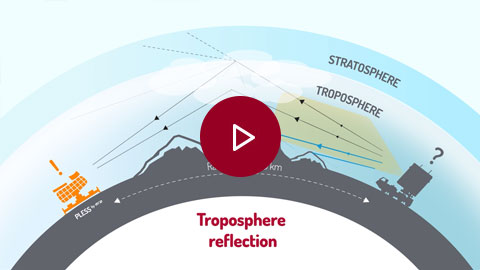PLESS
Break
the horizon
Passive Long-range ESM Surveillance System (PLESS) is a passive Over-The-Horizon (OTH) Direction Finding (DF) system developed by ERA. This direction finding system can detect, locate, identify and track air, land and naval targets with a focus on slow-moving or stationary platforms. The system processes signals from radars, jammers and datalinks.
Using the unique passive detection technology by ERA, the PLESS direction finding system provides a covert mode of operation, ideal for long-term cross-border and maritime surveillance. Thanks to the utilization of tropospheric reflectivity properties, the PLESS direction finding system can see targets located even beyond the radio horizon.
Key features
- Passive – using the signals emitted by the target itself
- Long-range – use of the tropospheric reflectivity properties
- Direction Finding (AoA) supported by multilateration (TDOA)
- 2D localization and tracking in case of multistatic deployment
- Pulsed and Continuous Wave (CW) signal processing and analysis
- Contribution to Emitter Database (EDB)
- ELINT features (classification, recognition and identification)
- Long-term Area of Interest (AoI) survey and early warnings
- Shared ecosystems with VERA-NG Passive ESM Tracker (PET)
Use cases
Land
Detection, localization, tracking, and identification of long, medium and short-range radars as a part of the Ground Based Air Defense and surveillance network. Beside radar signals the system can also process communication signals (datalinks, jammers).
Sea
Detection, localization, tracking and identification of various emitter types based on naval platforms. The identification process can be supported by the Automatic Identification System (AIS) used by the vessel.
Air
Long-range situational awareness – detection and identification of airborne platforms. The PLESS system can also detect and localize the Ground Control Segment of the Unmanned Aerial Systems (UAS).
ELINT (Electronic intelligence)
A key role of PLESS is ELINT functionality – data collection and exploitation (classification, recognition and identification). The received signals can be evaluated manually by an operator or by an automatic Non-cooperative Target Identification process. Both tasks require the Emitter database (EDB) to be present. In addition, the sensor is designed to generate relevant parametrical EDB records which can be shared in real-time with other EDB based equipment such as PET (e.g. VERA-NG), Radar Warning Receivers and other EW equipment through higher echelons via standard data exchange formats.

Do you have questions?
Just drop us a line. We will answer as soon as possible.


